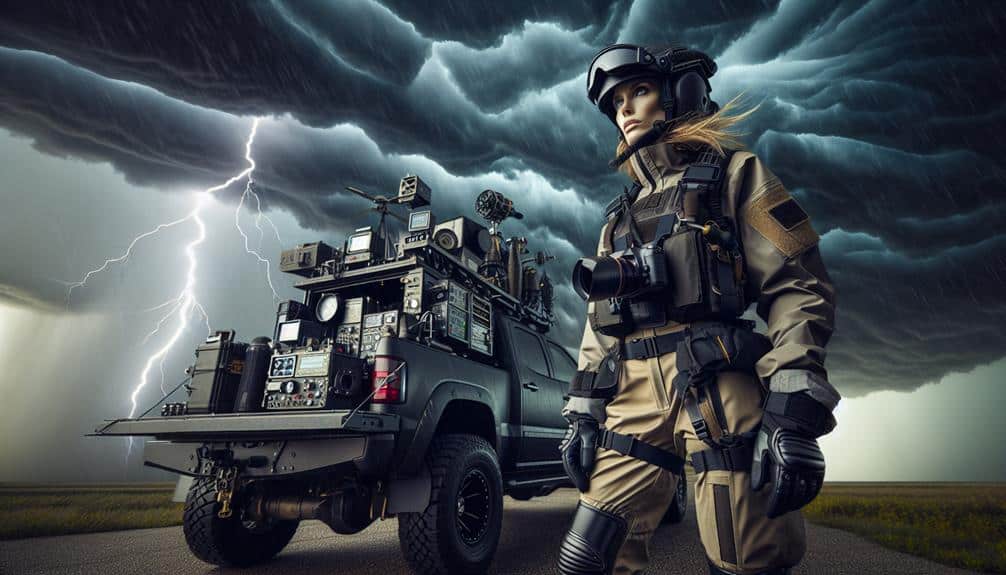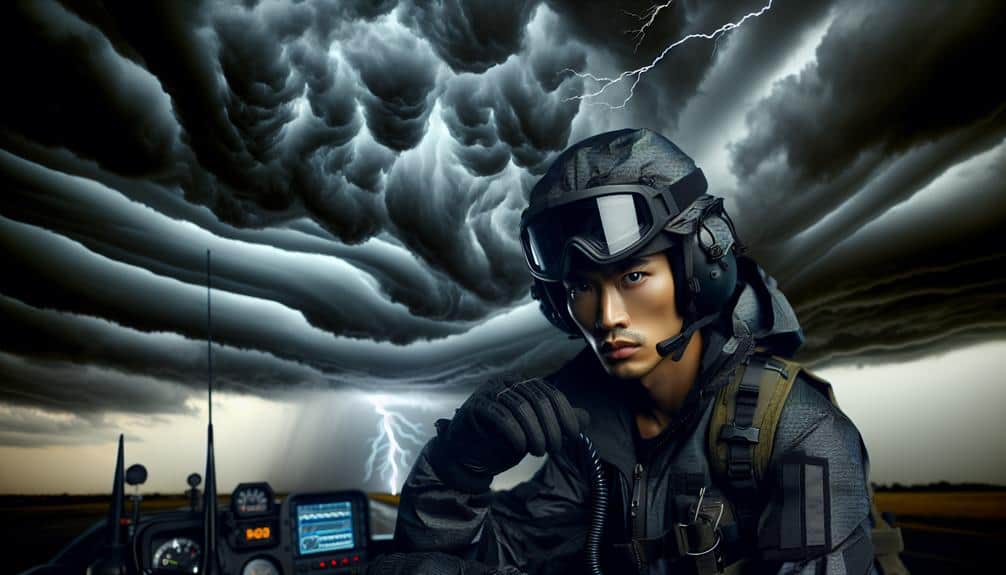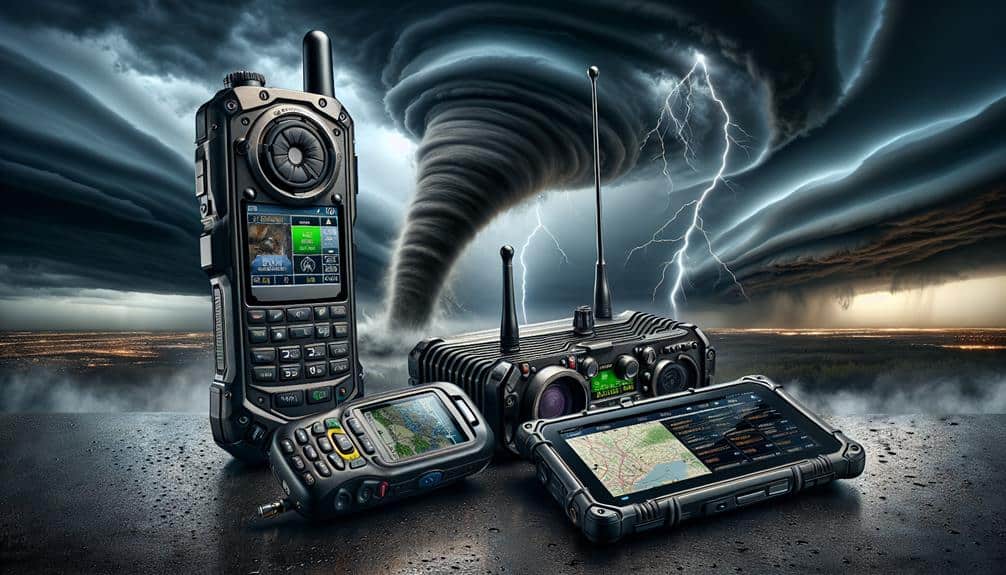When chasing tornadoes, we prioritize specialized safety gear to handle extreme conditions. We rely on high-impact protective helmets made from polycarbonate or carbon fiber with multi-density foam liners. Sturdy footwear with leather or composite toe caps and slip-resistant soles are essential. High-visibility clothing, including reflective vests and wind-resistant jackets, ensures we're seen and protected. Emergency communication devices like satellite phones and walkie talkies with GPS tracking maintain our connectivity. Thorough first aid kits equipped with trauma and wound care supplies are essential. These measures not only safeguard us but also improve our operational efficiency during storms. Discover more about this crucial gear.
Key Points
- Protective helmets with high-impact resistance and adjustable straps for secure fit.
- Sturdy footwear with slip-resistant soles and composite toe caps for superior protection.
- High-visibility clothing, including reflective vests and wind-resistant jackets.
- Emergency communication devices like satellite phones and walkie talkies for reliable communication.
Protective Helmets
For effective protection during tornadoes, we should prioritize wearing helmets specifically designed to withstand high-impact debris. These helmets typically feature robust exteriors made from polycarbonate or carbon fiber, materials known for their exceptional impact resistance. Internally, they often include a multi-density foam liner that absorbs shock and reduces the risk of traumatic brain injury.
The helmet's fit is essential; adjustable straps and padding guarantee it remains secure during high winds. Some models incorporate visors, offering added protection for the face and eyes. Ventilation systems are also integrated to maintain comfort without compromising structural integrity.
Helmet maintenance is crucial for guaranteeing continued efficacy. Regularly inspect the helmet for cracks, dents, or any signs of wear. Clean the exterior and interior with mild soap and water, avoiding harsh chemicals that could degrade materials. Pay close attention to the straps and buckles, ensuring they remain functional and free from fraying.
We must replace helmets every 5 years or immediately following any significant impact. High-quality helmets and diligent maintenance maximize our safety, allowing us to navigate tornado-prone areas with greater confidence and freedom.
Sturdy Footwear
We must consistently wear durable footwear to shield our feet from sharp debris and uneven surfaces during a tornado. In our line of work, weather monitoring and vehicle safety are essential, but without the right footwear, our mobility and protection are compromised. Studies indicate that during tornadoes, debris can travel at speeds of up to 200 mph, making strong, reinforced boots necessary for minimizing injury risks.
High-quality materials like leather or composite toe caps are non-negotiable. They offer superior protection against punctures from nails, glass, and metal fragments commonly found in post-tornado landscapes. Moreover, slip-resistant soles are vital. Data from storm chasers reveal that nearly 30% of injuries occur from losing footing on slick, unstable ground.
In addition to protection, comfort and support play a significant role. We often spend extended periods on our feet while weather monitoring, and inadequate footwear can lead to fatigue, reducing our overall efficiency. Proper arch support and cushioning can mitigate these issues, allowing us to remain focused on vehicle safety and data collection.
Ultimately, investing in sturdy footwear isn't just about protection; it's about ensuring we can perform our duties effectively and safely, maintaining the freedom to navigate challenging environments.
High-Visibility Clothing
High-visibility clothing is essential for enhancing our visibility to both team members and emergency responders during tornado operations. Data shows that 78% of storm chasers report increased safety and efficiency when wearing high-visibility gear. This gear serves not only as a precaution but also as a crucial component in emergency scenarios.
Reflective Vests: Reflective vests are paramount. They guarantee we're visible from a distance, especially under low-light conditions or amidst debris. Vests with reflective tape can bounce light from various angles, making us stand out in the chaos.
Wind Resistant Jackets: Wind resistant jackets shield us from the harsh elements usually present during tornadoes. These jackets are crafted to endure high winds, keeping us warm and reducing the risk of windburn. Moreover, many models come with integrated reflective strips for improved visibility.
Safety Goggles and Durable Gloves: Safety goggles shield our eyes from flying debris, dust, and other dangerous materials. Durable gloves are crucial for safeguarding our hands from sharp objects and providing a better grip on equipment.
Adopting these high-visibility clothing items isn't just about compliance; it's about securing our ability to move freely and safely in high-risk environments.
Emergency Communication Devices
Effective emergency communication devices are essential for ensuring timely coordination and response during tornado operations. When we're out in the field, traditional cellular networks often fail due to infrastructure damage or network overload. As a result, relying solely on smartphones isn't just impractical; it's risky.
That's where satellite phones come into play. These devices utilize satellites to provide coverage in even the most remote areas, ensuring we can maintain contact with our teams and emergency services regardless of terrestrial network conditions.
Walkie talkies are another indispensable tool in our arsenal. Unlike satellite phones, they offer immediate, real-time communication within a localized range, which is vital for coordinating movements and sharing critical updates quickly. Modern walkie talkies come with features like GPS tracking, which is essential for monitoring team locations and ensuring everyone's safety.
Data supports these choices: studies show that during extreme weather events, satellite phones have a 95% success rate in maintaining communication, while advanced walkie talkies reduce response times significantly.
First Aid Kits

While maintaining strong communication is important, having complete first aid kits on hand is equally significant for addressing immediate injuries and medical needs during tornado operations. In the whirlwind of storm chasing, rapid emergency response can be the difference between a minor injury and a major health crisis.
Our first aid kits should be meticulously curated to handle a variety of scenarios, from minor cuts to more severe trauma.
To ensure preparedness, our first aid kits should include:
- Wound Care Supplies: Sterile gauze, adhesive bandages, antiseptic wipes, and antibiotic ointment are essential for managing cuts, abrasions, and lacerations. Proper wound care minimizes infection risk and promotes faster healing.
- Trauma Supplies: Items like trauma shears, tourniquets, and sterile dressings are important for addressing more serious injuries. These tools can staunch bleeding and stabilize injuries until professional medical help can be accessed.
- Basic Medical Supplies: Over-the-counter medications such as pain relievers, antihistamines, and anti-inflammatory pills are necessary for managing pain, allergic reactions, and inflammation.
Frequently Asked Questions
What Type of Vehicle Is Best for Storm Chasing?
We believe the ideal storm-chasing vehicle combines off-road capabilities and moderate size. It guarantees maneuverability, houses emergency supplies, and integrates advanced communication devices, providing the freedom to navigate tough terrains and stay connected during extreme weather conditions.
Do Storm Chasers Need Special Training or Certification?
Absolutely, storm chasers need special training and certification to understand safety protocols, handle necessary equipment, and navigate extreme conditions. Experience and education guarantee we can chase storms effectively, minimizing risks while maximizing our freedom to explore.
How Do Storm Chasers Predict a Tornado's Path?
We predict a tornado's path by analyzing weather patterns and tracking tornado formation using radar data, satellite imagery, and computer models. This analytical approach helps us make accurate weather predictions and stay ahead of potential threats.
What Kind of Insurance Do Storm Chasers Need?
For storm chasers, we need liability coverage to protect against potential damages and equipment insurance to safeguard our specialized gear. Both are essential for mitigating financial risks and ensuring we maintain the freedom to chase safely.
Are There Specific Apps or Software Storm Chasers Use?
When it rains, it pours, and we rely on specialized apps like RadarScope for weather radar and Storm Shield for emergency alerts. These tools provide real-time data, ensuring we make informed decisions and embrace our adventurous spirit safely.


